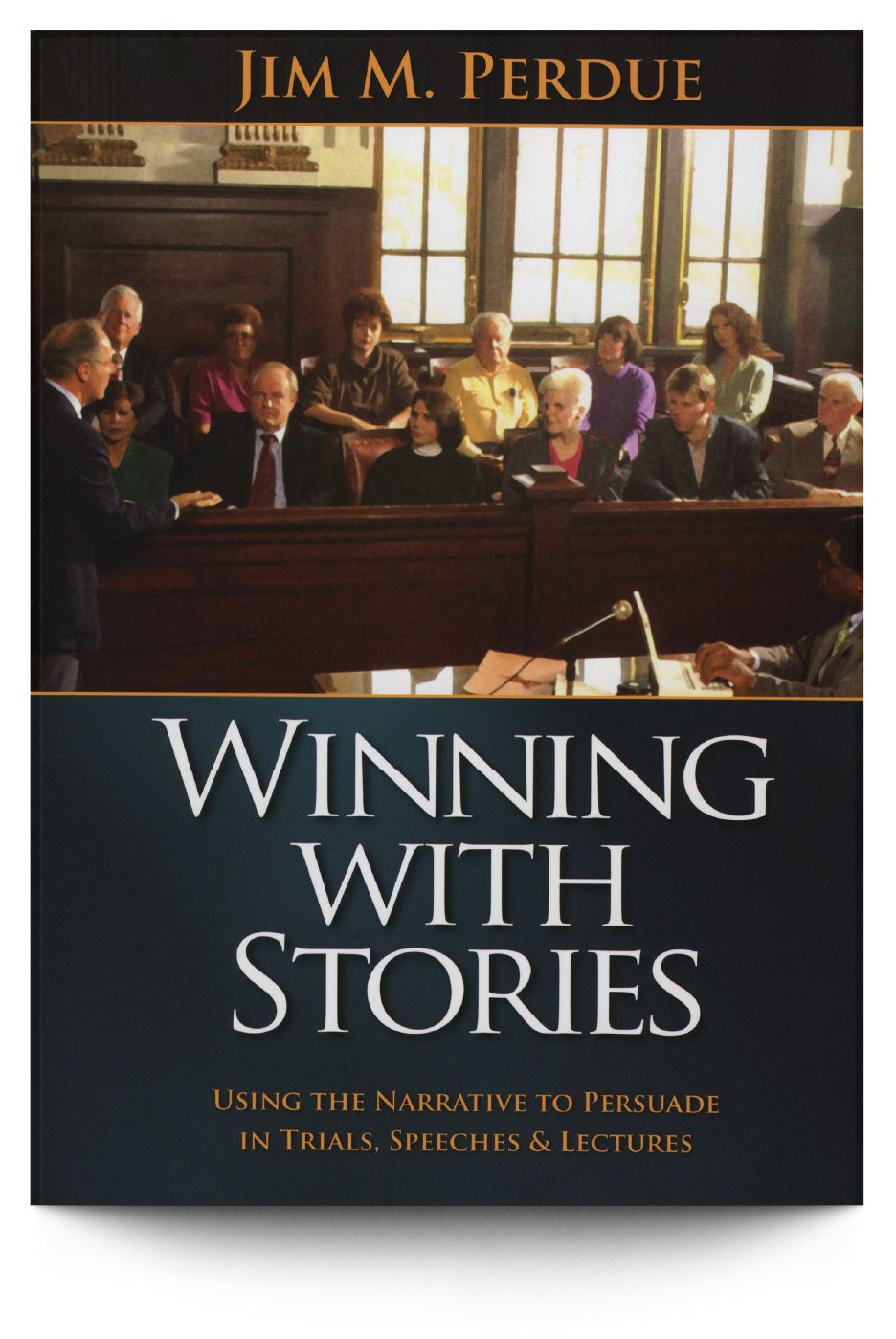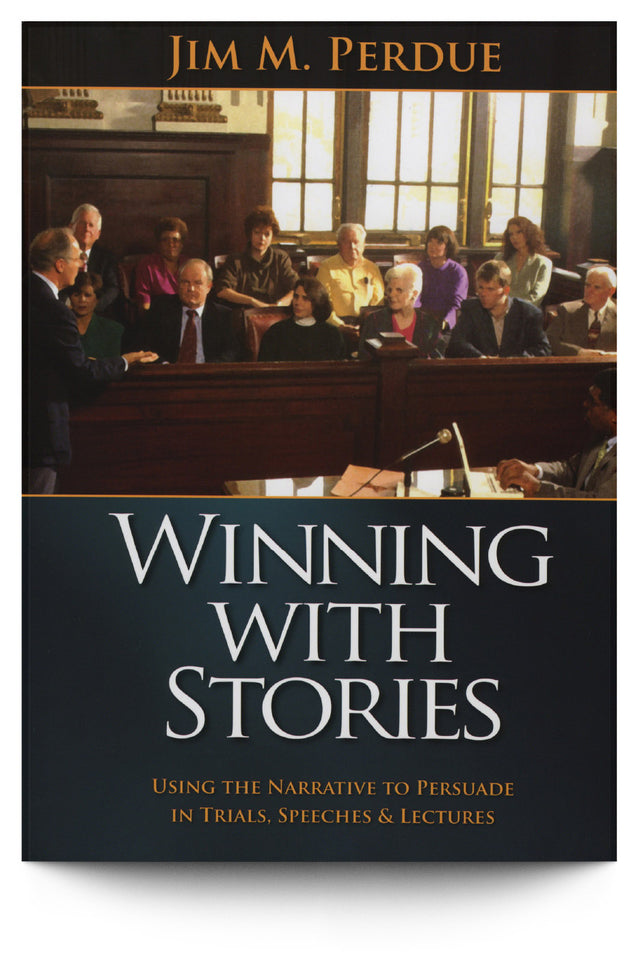Description
Description
"Once upon a time ..."
So begins Winning with Stories: Using the Narrative to Persuade in Trials, Speeches and Lectures, an examination of the power of the story in the art of persuasion. In this eminently readable work of sound scholarship, author Jim M. Perdue proves that the story, as our primary vehicle for learning and teaching, is as valid today as it was to our ancient ancestors. "Stories reaffirm our belief that our institutions exist as solutions to problems," writes Perdue. "Stories deny the proposition that life can only admit to hopelessness and uncertainty. Since the beginning of time, narratives have carried the truths of hope and justice."
Beginning with an exploration of the story concept, Perdue analyzes narrative elements in detail, showing how to craft a story with a strong beginning, memorable scenes, believable characters, a logical plot, vivid action, and a moving conclusion. Going beyond these basics, Perdue demonstrates how to tell the story to maximum effect, with attention to concepts as broad as giving "soul" to the story and as specific as what the speaker should wear. Perdue covers mannerisms, physical movement, use of illustrative visuals, and other storytelling considerations in detail. The author gives generously of his more than forty years of courtroom experience to show novice and veteran lawyers alike how to tell a powerful story to motivate an audience.
Far more than a practical analysis of storytelling, Winning with Stories is also an invaluable anthology of stories that speakers can use to make and illustrate a point. Perdue includes abundant examples of useful labels, metaphors, similes, clichés, analogies, quotations, poetry, personal anecdotes, and humorous stories. He traces them to their roots in ancient and modern history, the Bible, children's tales, books, movies, plays, and folklore. Rounding out these invaluable resources are illustrative examples of actual opening statements and closing arguments the author has used to inspire juries to a just verdict.
Like Perdue's previous books, Winning with Stories will be an indispensable reference for the trial lawyer seeking more effective persuasion techniques and an invaluable tool for lecturers, ministers, and teachers—anyone who studies or practices the art of persuasion.
Author
Author
Details
Details
Hardcover: 602 pages; 1st edition (2006); ISBN: 978-1892542229
Publisher: State Bar of Texas
Table of Contents
Table of Contents
- Letter from the President of the State Bar of Texas
- Preface
- Acknowledgments
- Part 1: The Story Concept
- The Power of the Story
- Why a Story?
- Part 2: Crafting A Story
- The Strong Begining
- Setting the Scene
- Developing Strong Characters
- Presenting a Compelling Plot
- Let the Audience Live the Action
- Choosing a Cognitive Theme
- Negating the Negatives
- Complete the Circle with a Strong Ending
- Part 3: Telling The Story
- The Power of the Person
- The Power of the Telling
- The Power of the Sequence
- The Power of the Pictures
- The Power of the Story from Adverse Witnesses: Cross-Examination Storytelling
- Part 4: Our Values
- The Source of the Trial Lawyer's Values and Beliefs
- Consider Your Audience
- Inspiring with Your Trial Story
- Part 5: Stories Within Stories
- Labels
- Metaphors
- Similes and Cliches
- Analogies
- Quotations
- Poetry
- Anecdotes and Humorous Stories
- Part 6: Courtroom Stories
- Illustrative Opening Statement: Truck-Auto Collision Kills Plaintiff's Son
- Illustrative Opening Statement: Premises-Unsafe Ladder
- Illustrative Closing Summation: Baby Brain Damaged at Birth Due to Obstetrical Nursing Negligence
- Illustrative Closing Summation: Pathology Mistake Leaves Woman Disfigured
- Illustrative Closing Summation: Anesthesia Misadventure Kills husband
- Notes
- Bibliography
- Story Morals Index
- Name and Title Index
- Subject Index
What Legal Leaders Are Saying
— Peter T. Hoffman, director of the Blakely Advocacy Institute, University of Houston Law CenterJim M. Perdue has put on paper what makes him a courtroom legend. This is the best guide yet on how to persuade judges and juries. Read it, study it, follow its step-by-step approach, and you are guaranteed to become a better trial lawyer.
— Wayne Fisher, Houston, TexasJim Perdue’s collection of stories, anecdotes and quotations is a veritable treasure trove of source material for trial lawyers and public speakers. In Lincolnesque style, these stories and witticisms are not only entertaining, but are replete with jewels of wisdom and historical insights.
— Dennis Donnelly, past president of the Inner Circle of AdvocatesIt’s not just trial lawyers who need to read this book. Teachers and all public speakers who care about their audience and their topic should also read its simple yet profound message. You can persuade an audience far better and move your listeners more deeply with a story than with an argument.
— Patrick Malone, past president of the Trial Lawyers Association of Metropolitan Washington, D.C. and coauthor of Rules of the Road: A Plaintiff Lawyer’s Guide to Proving LiabilityPerdue’s big-as-all-outdoors book doesn’t just give us formulas and checklists, it also mines deeply into literature and culture to show how the great stories of the last few thousand years have worked their persuasive magic. This is a book to read and savor, and refer to over and over.
— Jeff Berger, senior pastor of South Avenue Baptist Church, Pasadena, TexasThis book is an amazingly useful tool for any communicator. Within the first two chapters, I found myself analyzing my next Sunday’s sermon, asking, ‘Have I stated my point in a vivid way, or an inert one? Will my congregation learn, remember, and be inspired?’
— Jack Olender, Washington, D.C.A Bible of the art of trial, Winning with Stories cuts the learning curve for young lawyers by ten or fifteen years.
— William B. English, director of speech communication, Baylor UniversityA must-read for all litigators who want to win, and should be a required text for all who study or practice persuasion.
— Jim Fitzgerald, Cheyenne, WyomingThe power of story is as old as humans and fire, and the fire of Jim Perdue comes through the pages of this book. It is an outstanding resource. Read it—and you will be a better lawyer.
— Stephen Hancock, educatorAtticus Finch surely spun some spellbinding tales for Scout and southern juries, but even he would be envious of Mr. Perdue’s talent for storytelling and his grasp of its tradition and power. This is a fascinating, informative book, and one that English teachers could use as effectively as attorneys.
— Don Keenan, past president of the Inner Circle of AdvocatesEvery Jim Perdue book is on my shelf, but the new one on storytelling and analogies won’t ever have any dust settle on top… it’s Jim’s best work.




